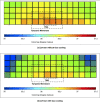Re-visiting the tympanic membrane vicinity as core body temperature measurement site
- PMID: 28414722
- PMCID: PMC5393563
- DOI: 10.1371/journal.pone.0174120
Re-visiting the tympanic membrane vicinity as core body temperature measurement site
Abstract
Core body temperature (CBT) is an important and commonly used indicator of human health and endurance performance. A rise in baseline CBT can be attributed to an onset of flu, infection or even thermoregulatory failure when it becomes excessive. Sites which have been used for measurement of CBT include the pulmonary artery, the esophagus, the rectum and the tympanic membrane. Among them, the tympanic membrane is an attractive measurement site for CBT due to its unobtrusive nature and ease of measurement facilitated, especially when continuous CBT measurements are needed for monitoring such as during military, occupational and sporting settings. However, to-date, there are still polarizing views on the suitability of tympanic membrane as a CBT site. This paper will revisit a number of key unresolved issues in the literature and also presents, for the first time, a benchmark of the middle ear temperature against temperature measurements from other sites. Results from experiments carried out on human and primate subjects will be presented to draw a fresh set of insights against the backdrop of hypotheses and controversies.
Conflict of interest statement
Figures










Similar articles
-
[Infrared temperature measurement in the ear canal with the DIATEK 9000 Instatemp and the DIATEK 9000 Thermoguide. Comparison with methods of temperature measurement in other body parts].Anaesthesist. 1996 Nov;45(11):1059-66. doi: 10.1007/s001010050340. Anaesthesist. 1996. PMID: 9012301 Clinical Trial. German.
-
[Comparative study of tympanic and mercury thermometry in children].Gac Med Mex. 1998 Jan-Feb;134(1):9-14. Gac Med Mex. 1998. PMID: 9658694 Spanish.
-
An evaluation of infra-red tympanic thermometry for thermal physiology research.J R Army Med Corps. 1997 Oct;143(3):149-52. doi: 10.1136/jramc-143-03-04. J R Army Med Corps. 1997. PMID: 9403821
-
Is tympanic membrane thermometry the best method for recording temperature in children?J Child Health Care. 2006 Jun;10(2):96-110. doi: 10.1177/1367493506062550. J Child Health Care. 2006. PMID: 16707539 Review.
-
Thermal mapping: Assessing the optimal sites for temperature measurement in the human body and emerging technologies.Physiol Rep. 2024 Jul;12(14):e16155. doi: 10.14814/phy2.16155. Physiol Rep. 2024. PMID: 39039617 Free PMC article. Review.
Cited by
-
Estimation of cardiovascular drift through ear temperature during prolonged steady-state cycling: a study protocol.BMJ Open Sport Exerc Med. 2021 Mar 23;7(1):e000907. doi: 10.1136/bmjsem-2020-000907. eCollection 2021. BMJ Open Sport Exerc Med. 2021. PMID: 33880185 Free PMC article.
-
Solar radiation and the validity of infrared tympanic temperature during exercise in the heat.Int J Biometeorol. 2020 Jan;64(1):39-45. doi: 10.1007/s00484-019-01791-1. Epub 2019 Aug 31. Int J Biometeorol. 2020. PMID: 31473810
-
SARS-CoV-2 (Covid-19) workplace temperature screening: Seasonal concerns for thermal detection in northern regions.Appl Ergon. 2022 Jan;98:103576. doi: 10.1016/j.apergo.2021.103576. Epub 2021 Sep 1. Appl Ergon. 2022. PMID: 34488191 Free PMC article.
-
Accuracy and precision of non-invasive thermometers compared with the pulmonary artery temperature: a cross-sectional study.Sao Paulo Med J. 2024 Nov 22;142(6):e2023409. doi: 10.1590/1516-3180.2023.0409.R1.05062024. eCollection 2024. Sao Paulo Med J. 2024. PMID: 39607221 Free PMC article.
-
Can ten days of heat acclimation training improve temperate-condition rowing performance in national-level rowers?PLoS One. 2022 Sep 1;17(9):e0273909. doi: 10.1371/journal.pone.0273909. eCollection 2022. PLoS One. 2022. PMID: 36048867 Free PMC article.
References
Publication types
MeSH terms
LinkOut - more resources
Full Text Sources
Other Literature Sources

